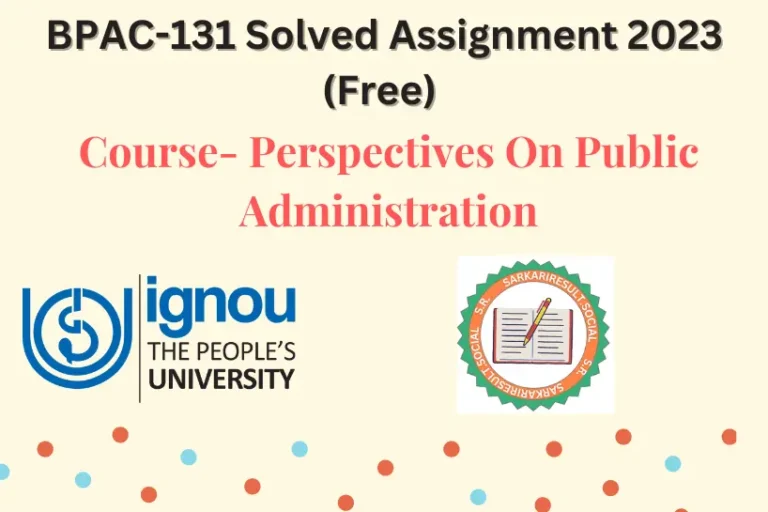BPAG 172 SOLVED IGNOU ASSIGNMENT FREE PART 2

Welcome to the BPAG 172 SOLVED IGNOU ASSIGNMENT FREE PART 2 TMA. Assignment B streamlines your approach with concise answers to three pivotal questions. In about 250 words each, explore the various forms of stakeholder involvement in governance, examine the key challenges of governance, and elaborate on the important role of media in governance. Our short and focused responses provide a straightforward path for grasping these critical aspects, ensuring a smooth and successful completion of your assignments.

Answer the following questions in about 250 words each.
Q.3 The involvement of stakeholders in governance takes various forms: Elaborate.
Ans. Stakeholder involvement is crucial for effective and inclusive governance, ensuring that decisions consider the perspectives and interests of those impacted. The involvement of stakeholders takes various forms, reflecting the diversity of interests and actors in the governance process.
1. Public Consultations:
– Description: Governments often conduct public consultations to gather input on proposed policies, projects, or legislative changes. This involves seeking feedback from citizens, communities, and organizations.
– Purpose: To incorporate diverse perspectives, address concerns, and promote participatory decision-making.
2. Participatory Budgeting:
– Description: Participatory budgeting allows citizens to directly engage in the allocation of public funds. Communities contribute ideas and preferences for budget priorities, fostering a sense of ownership.
– Purpose: Enhances transparency, accountability, and responsiveness to local needs in budgetary decisions.
3. Stakeholder Committees and Advisory Boards:
– Description: Establishing committees or advisory boards comprising representatives from various stakeholders, including community leaders, industry experts, and NGOs.
– Purpose: Provides specialized expertise, diverse viewpoints, and ensures that decisions align with the broader interests of stakeholders.
4. Public-Private Partnerships (PPPs):
– Description: Collaborations between public and private entities to deliver public services or infrastructure projects. Involves shared decision-making and risk-sharing.
– Purpose: Leverages private sector efficiency, innovation, and resources while ensuring public oversight.
5. Corporate Social Responsibility (CSR):
– Description: Involves businesses engaging with communities and addressing social or environmental issues voluntarily. Stakeholder engagement is integral to CSR initiatives.
– Purpose: Enhances corporate accountability, builds positive relationships with communities, and contributes to sustainable development.
6. Social Impact Assessments (SIAs):
– Description: Assessments conducted before major projects to identify and address potential social impacts. Involves consultation with affected communities.
– Purpose: Minimizes negative impacts, incorporates local knowledge, and ensures fair compensation or mitigation measures.
7. Online Platforms and Technology:
– Description: Utilizing digital platforms for public engagement, feedback, and consultation. Online surveys, forums, and social media enable broader participation.
– Purpose: Expands outreach, especially among the younger population, and facilitates real-time feedback.
8. Community-Based Organizations (CBOs):
– Description: Local community groups or NGOs that represent specific interests. They often engage with governments on behalf of their communities.
– Purpose: Ensures that decisions consider the unique needs and perspectives of specific communities.
9. Union Participation:
– Description: Involvement of labor unions in discussions related to labor policies, workplace conditions, and industrial disputes.
– Purpose: Represents the interests of workers, ensures fair labor practices, and contributes to social dialogue.
10. Multi-Stakeholder Partnerships:
– Description: Collaborative efforts involving governments, businesses, civil society, and international organizations to address complex issues.
– Purpose: Leverages diverse expertise, resources, and perspectives for comprehensive problem-solving.
These various forms of stakeholder involvement recognize the importance of inclusivity, transparency, and shared decision-making in governance processes. Effective stakeholder engagement contributes to better-informed decisions, increased legitimacy, and the creation of policies and projects that better reflect the diverse needs and aspirations of the community.
Q.4 Examine the key challenges of governance.
Ans. Governance faces several key challenges that can impede effective decision-making, implementation, and overall democratic functioning.
1. Corruption:
Corruption remains a pervasive challenge, eroding public trust and diverting resources meant for public welfare. Addressing corruption requires robust anti-corruption measures, transparency, and accountability mechanisms.
2. Bureaucratic Inefficiency:
Bureaucratic red tape and inefficiency hinder the smooth functioning of governance. Streamlining bureaucratic processes, promoting meritocracy, and embracing digital solutions are essential to enhance efficiency.
3. Political Instability:
Political instability, characterized by frequent changes in leadership or unstable coalition governments, can disrupt long-term policy planning and implementation. It requires stable political environments for effective governance.
4. Lack of Inclusivity:
Governance that fails to include diverse voices and perspectives can lead to policies that do not address the needs of all segments of society. Promoting inclusivity and engaging marginalized communities are critical for equitable governance.
5. Limited Access to Information:
Inaccessible or controlled information inhibits transparency and citizen engagement. Ensuring open access to information through mechanisms like the Right to Information (RTI) is crucial for an informed citizenry.
6. Weak Rule of Law:
Weaknesses in the rule of law contribute to arbitrary decision-making and uneven justice. Strengthening legal frameworks, judicial independence, and law enforcement are essential for effective governance.
7. Economic Disparities:
Economic disparities can lead to unequal access to opportunities and resources, exacerbating social tensions. Policies addressing economic inequality are vital for inclusive and stable governance.
8. Global Challenges:
Addressing global challenges, such as climate change, requires coordinated efforts across borders. Global governance mechanisms and cooperation are essential to tackle issues that transcend national boundaries.
9. Security Concerns:
Ongoing security challenges, including terrorism and cyber threats, pose complex governance challenges. Striking a balance between security measures and protecting civil liberties is a delicate task.
10. Technological Transformations:
Rapid technological advancements present challenges in adapting governance structures to harness the benefits of technology while mitigating risks such as data privacy violations and cyber threats.
11. Demographic Pressures:
Rapid population growth in some regions strains resources and services, requiring effective governance to manage demographic challenges such as urbanization and demands on healthcare and education.
Addressing these challenges requires a holistic and adaptive approach, involving a combination of legal reforms, institutional strengthening, citizen engagement, and international cooperation. Overcoming these hurdles is essential for fostering responsive, accountable, and resilient governance systems.
Q.5 Media has an important role in governance- Elaborate.
Ans. Media plays a pivotal role in governance by serving as a bridge between the government and the public, fostering transparency, accountability, and public participation. Here are key aspects of the media’s vital role in governance:
1. Information Dissemination:
Media acts as a primary source of information, keeping the public informed about government policies, decisions, and activities. Timely and accurate reporting enables citizens to make informed choices and hold officials accountable.
2. Public Accountability:
By scrutinizing government actions and policies, the media holds public officials accountable for their decisions. Investigative journalism uncovers corruption, maladministration, and other wrongdoings, fostering a culture of accountability.
3. Facilitating Public Discourse:
Media provides a platform for public discourse, enabling citizens to express their opinions, concerns, and grievances. This dialogue is essential for shaping policies that reflect the diverse needs of the population.
4. Monitoring Power:
Journalistic scrutiny acts as a check on governmental power. It prevents the abuse of authority and ensures that those in power are answerable to the public. Investigative reporting brings to light issues that might otherwise remain hidden.
5. Advocacy for Human Rights:
Media plays a crucial role in advocating for human rights by exposing human rights violations, social injustices, and issues related to marginalized communities. This advocacy contributes to shaping a just and equitable society.
6. Promoting Government Transparency:
Transparent governance is facilitated by the media’s role in revealing information about government operations, expenditures, and decision-making processes. This transparency builds public trust in governmental institutions.
7. Crisis Communication:
During crises, such as natural disasters or pandemics, media serves as a critical communication channel between the government and the public. Timely and accurate reporting helps disseminate crucial information and guidelines.
8. Educating the Public:
Media educates the public on civic responsibilities, government structures, and policy issues. Informed citizens are more likely to actively participate in democratic processes, contributing to a robust governance system.
9. Technology and Citizen Journalism:
Digital media and citizen journalism have expanded the reach of information. Social media platforms empower citizens to report and share news, influencing public opinion and contributing to a more participatory governance landscape.
10. International Perspective:
Through international reporting, media provides citizens with insights into global affairs, fostering an understanding of how global events impact local governance and policy decisions.
In conclusion, media serves as a cornerstone in the edifice of governance. Its ability to inform, question, and advocate contributes significantly to the health and vibrancy of democratic systems worldwide. A free and responsible media is essential for a well-informed citizenry and accountable governance.
Also See This: BPAG 172 SOLVED IGNOU ASSIGNMENT FREE PART 3







